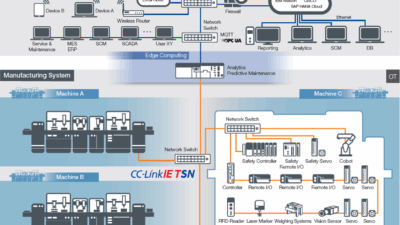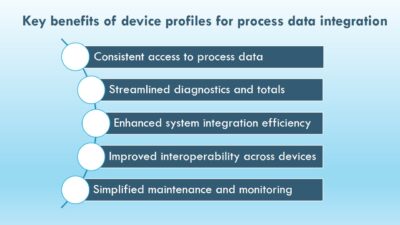Time-sensitive networking (TSN) is an evolution of standard Ethernet and adds the bounded latency and guaranteed bandwidth provided by hard real-time Ethernet, which is crucial as more devices are connected to the Industrial Internet of Things (IIoT).
Of the 50 billion devices it is said will be connected by the year 2020, experts estimate that the industrial sector will account for nearly half. This means that engineers and scientists have a big voice when it comes to implementing the Industrial Internet of Things (IIoT) across factories, test laboratories, power grids, refineries, and infrastructure.
The global processing industry is an early adopter of IIoT, and it’s easy to see why. Unscheduled asset downtime in the industry costs $20 billion annually, 80% of which is preventable, according to ARC Advisory Group. However, it’s not just the global processing industry that can benefit from IIoT. Among business leaders, 95% expect their companies to use the IIoT within the next 36 months.
Engineers can expect to gain three key benefits:
- Increased uptime with predictive maintenance
- Boosted performance with control at the edge
- Improved product design and manufacturing through connected, real-world data.
Today, the uptime of the most critical assets often depends on manual inspection by a few subject matter experts. Unfortunately, these experts are becoming harder to find, and manual monitoring is not scalable across an entire fleet of assets. It’s estimated that only 5% of data collected today is analyzed. IIoT helps illuminate the possibilities when using analytics and machine learning to predict the amount of remaining serviceable life of an asset and to schedule maintenance before a costly failure.
The second benefit involves increased and optimized performance. Smart machines deployed on production lines or in the field must be able to adjust parameters, such as temperatures or throughput, depending on information they receive from other machines upstream. The best way to boost performance for these systems involves full autonomy on the part of the machine or asset. In this case, if machines can learn, either from other machines or through their own experiences, they can then tune control parameters and better adapt to their surroundings.
The final benefit of IIoT is improved product design and production. This is sometimes referred to as "IIoT for R&D." Real-world data, such as usage data, is fed back into engineering to improve the next product generation. However, it’s not just about acquiring the data but also effectively managing it to gain valuable insights. The Jaguar Land Rover Co., for example, has hundreds of engineers who collectively generate more than 500 GB of time-series-data per day. Previously, the company analyzed only 10% of its data, but after implementing an IIoT solution, it increased that coverage to 95%. It can now address more design issues in a lesser amount of time.
Realization forthcoming
To realize the benefits of IIoT, design teams must depend on several core technologies. Regardless of whether it’s building an online monitoring system, smart manufacturing machine, or testing a physical electromechanical system, a key commonality is the need for intelligence at the edge. The more sophisticated systems get, the more decisions need to be made in real time. For example, the ability to acquire massive amounts of high-resolution analog waveform data for the structural test of a wind turbine blade is important to understanding the characteristics of its real-world behavior.
At the same time, that data needs to be processed to provide input to the control system that is actuating the blade to ensure the test is conducted under known conditions. So, it should be no surprise that experts estimate that at least 40% of all IIoT-created data will be stored, processed, analyzed, and acted on at the edge, according to IDC. To maximize performance and reduce unnecessary data transfers, you must push decision making down to edge nodes deployed at or near the "things."
In implementing these systems, new challenges appear-especially as systems grow in physical size and sensor count. Continuing with our structural test example, to get a full understanding of how a wind turbine blade will perform, the entire structure needs to be outfitted with sensors to measure strain, pressure, load, and torque. These sensors all produce analog signals, and to gain the most insight, high-speed, high-resolution measurements must be taken. For large-scale applications such as this, hundreds or even thousands of sensors might need to be distributed throughout the system. While we acquire all this data, it must be processed it in real time in order to provide the set points for all the actuators that control the system.
A few challenges arise when attempting to develop such a system:
- Synchronizing the potentially thousands of channels and numerous measurement systems
- Synchronizing the control systems such that all actuation happens at the correct time
- Synchronizing the measurements and control systems.
These challenges are further exaggerated as systems grow, and more measurement and control capabilities are added to an application. Synchronizing measurement systems with other measurement systems, and control systems with other control systems, is not a new challenge. Typically, this can be achieved with signal-based methods, in which physical cabling is used to route a common time base or signal to distributed nodes. Unfortunately, this has limitations on distance and scalability, as well as a risk of noise.
Another possibility
Another option is to leverage a protocol built on top of a common standard like Ethernet. Ethernet offers openness and interoperability but has no bounds for latency or guarantees for bandwidth. To solve this challenge, custom versions of Ethernet, often referred to as Hard Real-Time Ethernet, have been developed. EtherCAT, Profinet, and EtherNet/IP are prime examples. These custom variants of Ethernet provide hard real-time performance and best-in-class latency and control. However, each variant includes both hardware and software modifications to network infrastructure, which increases costs and means different devices from different vendors cannot function on the same network.
A new technology to solve this synchronization challenge is coming to market now, called time-sensitive networking (TSN). TSN is an evolution of standard Ethernet that provides openness and interoperability but adds the bounded latency and guaranteed bandwidth provided by hard real-time Ethernet. Specifically, TSN delivers three key components: time-based synchronization, traffic scheduling, and system configuration. The synchronization capabilities are based on the IEEE 1588 precision time protocol profile, providing a sub-microsecond level of network synchronization. In addition, traffic scheduling and system configuration power deterministic data communication, so users can schedule and prioritize time-critical data (such as control signals) across the network.
An important aspect of TSN is the convergence of time-critical traffic and other Ethernet traffic. Because TSN is a feature of the Ethernet standard, the new capabilities of time synchronization and deterministic communication run over the same network as other network communication. This means a single port on the measurement or control system can perform deterministic communication while also updating remote user interface terminals and supporting file transfer.
TSN is a key enhancement for many industrial applications, such as process and machine control, in which low communication latency and minimal jitter are critical to meeting closed-loop control requirements. Time-based synchronization over Ethernet also minimizes cabling traditionally found in monitoring applications and physical system testing (like our structural example) leading to a simpler, cost-effective solution without sacrificing reliability.
The introduction of TSN is a huge step forward in solving the whole system synchronization challenge. Another concern engineers developing these systems have is reducing the overall system complexity while maintaining or improving reliability. In our structural test example, the application can be developed to leverage TSN-based measurement and control systems, but there is still the challenge of programming the two in their respective environments and dealing with their respective data collection mechanisms.
Removing the challenge
Control systems like programmable logic controllers (PLCs) are often programmed in IEC 61131-3 languages and operate on single-point data. This type of data is ideal for control applications, but not suited for gaining insight—waveform data is needed for this. Similarly, measurement systems work in waveform data to deliver the needed insight but are not ideal for sending single-point control signals or reacting to them deterministically.
This characterization of measurement and control systems is black and white. There has been a slow convergence of measurement and control systems over the past several years. New capabilities have been added to each, such that more measurement systems can do some control, and vice versa. However, this continued convergence of measurement and control systems will have a major impact on IIoT applications in the future. Measurement and control systems will become synonymous, eliminating the need to deploy both systems. Measurement and control will be able to be done using a single software toolchain to acquire, process, log, and react to incoming data, ultimately leading to reduced system cost and complexity.
Having separate measurement and control systems naturally makes systems more complex since two independent systems must be created, often using disparate software tools and requiring multiple forms of expertise. Then those systems must be integrated together, which results in additional cabling and related considerations. This all leads to added cost and complexity-especially for large-scale systems like the structural test example.
Instead, a fully consolidated measurement and control platform should be considered. Such a platform would need to offer the measurement breadth, accuracy, channel scalability, and I/O synchronization needs of a measurement system as well as the customizability of a control system. By leveraging such a platform, test engineers, maintenance managers, and machine designers alike will have the necessary tools at their disposal to fully realize the benefits of the IIoT, while reducing the cost and complexity of their deployment.
Brandon Treece is a senior product marketing manager, National Instruments, Austin, TX.
Sources
Cisco, The Internet of Things: How the Next Evolution of the Internet Is Changing Everything, 2011.
IHS Markit, IoT Trend Watch 2017, 2017.
ARC Advisory Group, Passing the Insurance Acid Test with APM, March 17, 2011.
IDC—The Digital Universe of Opportunities: Rich Data and the Increasing Value of the Internet of Things.
IDC FutureScape: Worldwide Internet of Things 2017 Predictions, 2016.



